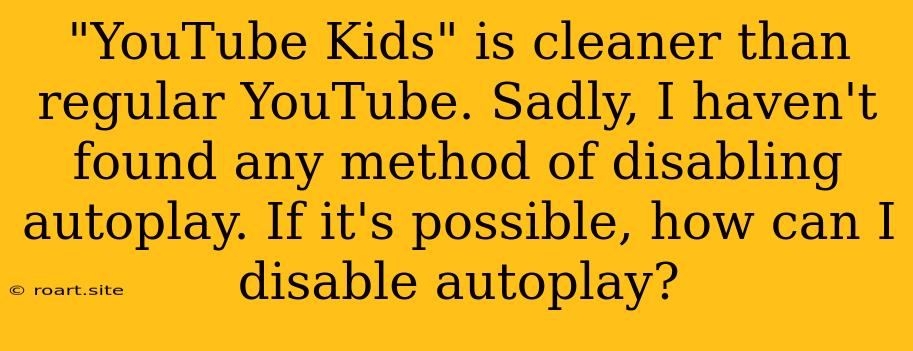YouTube Kids is a popular platform designed to provide a safe and age-appropriate viewing experience for children. While it offers a curated library of content, one common frustration for parents is the automatic playback feature, which can lead to unintended viewing and potentially unwanted content. Many parents seek ways to disable autoplay on YouTube Kids to control their child's viewing experience better. While the app currently lacks a built-in option to disable autoplay entirely, there are workarounds and alternative methods to manage this feature.
Understanding Autoplay on YouTube Kids
Autoplay is a feature that automatically starts playing the next video in a playlist or recommended videos once the current one finishes. This can be helpful in keeping children entertained, but it can also lead to them watching content that they might not be interested in or that is inappropriate for their age. The lack of control over autoplay can also lead to children accidentally clicking on inappropriate videos or spending more time than intended on the platform.
Why Disabling Autoplay is Important
Disabling autoplay on YouTube Kids is crucial for several reasons:
- Parental Control: It allows parents to have greater control over what their children watch and for how long. Parents can curate their child's viewing experience by choosing specific videos or playlists and ensuring that they don't accidentally stumble upon inappropriate content.
- Preventing Unintended Viewing: Autoplay can lead to children accidentally watching content that is not intended for them or that they might find disturbing. This can be particularly problematic for younger children who may not be able to distinguish between appropriate and inappropriate content.
- Screen Time Management: Autoplay can contribute to excessive screen time, especially if children are repeatedly exposed to new videos that keep them engaged. By disabling autoplay, parents can set limits on how long their children spend watching videos on YouTube Kids.
- Promoting Active Engagement: Disabling autoplay encourages children to actively choose the videos they want to watch. This helps them develop critical thinking skills and decision-making abilities, rather than passively consuming whatever content is presented to them.
Methods for Managing Autoplay on YouTube Kids
While YouTube Kids doesn't offer a direct setting to disable autoplay, there are several strategies that parents can employ to manage the feature:
1. Using the "Stop" Button
The most straightforward way to prevent autoplay is to manually press the "Stop" button after each video. This requires active parental involvement, but it's effective in preventing unwanted autoplay.
2. Utilizing the "Next" Button
Instead of relying on autoplay, parents can use the "Next" button to manually select the next video. This method encourages children to make active choices about what they want to watch.
3. Disabling Autoplay in the Browser
If using YouTube Kids through a web browser, some browsers offer built-in features to disable autoplay for all websites. While this won't specifically disable autoplay within the YouTube Kids platform, it can help manage autoplay across all websites, including YouTube.
4. Using Parental Control Apps
Several parental control apps offer specific features to manage YouTube Kids, including disabling autoplay. These apps can monitor and restrict children's access to content, set time limits, and control other features.
5. Utilizing the "Watch Later" Feature
Encouraging children to use the "Watch Later" feature can help manage autoplay. After watching a video, they can add it to their "Watch Later" list and view it later at a designated time.
6. Engaging in Active Viewing
Parents can actively engage in viewing sessions with their children, selecting videos together and discussing the content. This approach fosters a more interactive and controlled viewing experience.
Importance of Open Communication
It's important to have open communication with children about the use of YouTube Kids. Parents should explain the concept of autoplay and the importance of making conscious choices about the videos they watch. This can help children understand the importance of responsible online behavior and prevent them from accidentally watching inappropriate content.
Conclusion
While YouTube Kids doesn't offer a native feature to disable autoplay, parents can use a combination of strategies to manage this feature and provide a more controlled viewing experience for their children. By utilizing the methods described above and engaging in open communication, parents can create a safer and more beneficial online environment for their children. The lack of a direct option to disable autoplay on YouTube Kids highlights the ongoing need for developers to prioritize user control and parental choices in designing online platforms for children.
